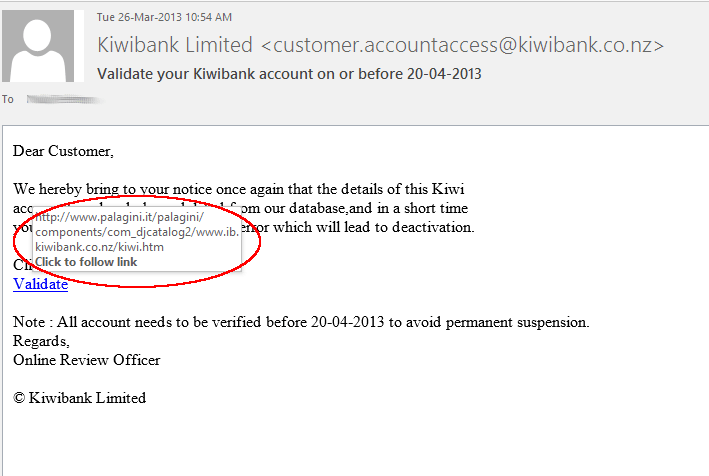Sign 1: Does that link really go where it says it does?
More often than not an email fraud message will ask you to click a link to verify your account or some other call to action. A quick way to spot a scam is to hover your mouse over the link and see if it really points to the site in question.
In the below example I have an email purportedly from Kiwibank who want me to verify my account details. As you can see when I hover over the link it does not link to Kiwibank at all but to another much less inviting URL. If you see this click delete on the email and carry on your day knowing you’ve saved your credentials from another devious attack:

However the correct web address will always show the banks name first, for example:

Sign 2: If you didn’t expect it is probably Fraud
A common way to get people to enter their information into a web site is to claim you have a package waiting, or some money to claim or any number of other options. Sure it might be a nice thought to think this is the case, but to this day I have never known UPS to want someone details via an email link for a package they were not expecting. If in doubt, delete it. If someone really does need those details they will make a concerted effort via phone to talk to you.
Sign 3: Is it too good to be true?
“Hi, I am Suzie Gorgeous-Pants, and I need a companion in your area to give me a better life….”, Sound familiar? It is easy to get sucked into such things.. But in the end it’s all a scam, we hear of people sinking hundreds or thousands of dollars into getting a companion who didn’t exist in the first place… DELETE
Sign 4: Can that official email editor speak English correctly?
“Kiwibank needs you verify your account in the immediacy”, It might not always be this obvious, but if you read the email thoroughly and find bad spelling, grammar or it just doesn’t make sense then it’s time for the quick DELETE. If that email really was from a bank, IRD, UPS or any other official channel it will have been vetted thoroughly for errors before being sent
Sign 5: The easiest one to spot
This is not always the case, but often while the name of the person sending to you might be Kiwibank for example, their actual email address may be Iamabigscammer @ nigeriantheft.com or something equally ridiculous. If you see this sort of thing in the from area of the email then DELETE, quick simple and effective

